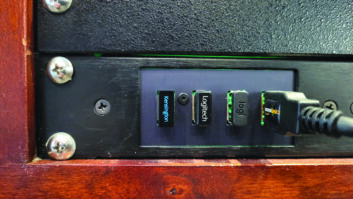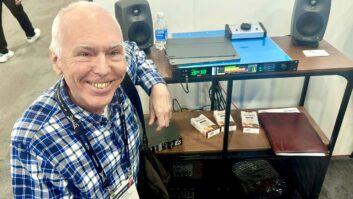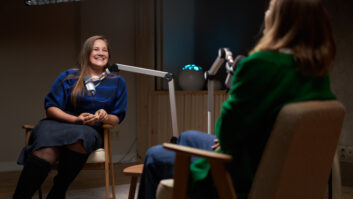ISDN is a mainstay for many stations – so much so that most stations have a backup ISDN line, and even a backup ISDN unit.
Wisconsin Public Radio developed a useful line-switching device to be shared with Workbench readers. Called the WYK Flipit Box, it was designed around the program “Whad’Ya Know?”
Two Telos Zephyr ISDN units are used with this adapter. Both Zephyr units are programmed so that their status outputs (pin 3 of the parallel port DB-15 connector) are activated should lines 1 or 2 (stereo mode) fail. Other programming options are available by referring to the Telos manual.
Should the main Zephyr fail, Flipit instantly will switch to the backup Zephyr, restoring the audio. Tests on the bench show that simulating a failure of the main audio source will switch instantly to the backup source, with no discernible interruption of the program.
(click thumbnail)Fig. 1
(click thumbnail)Fig. 2
(click thumbnail)Fig. 3
In reality, a failure in the main Zephyr may produce a momentary “hole” in the program, but this is certainly better than the seconds or minutes that it would take to either play with a patch panel, or redial the ISDN connection to restore audio.
Main and standby
Two simultaneous ISDN feeds are provided for the “Whad’Ya Know” origination. Flipit assumes that ISDN 1 box is the “main” unit. If the main unit fails, Flipit will switch automatically to the ISDN 2 box, and sound an alarm.
Operation of Flipit is straightforward. The dial-up connection is established with ISDN #1 and then ISDN #2. Then the ARM button is set. If a failure occurs, pressing RESET will toggle the audio back to ISDN #1.
The first stage of the Flipit box consists of two level shifters, consisting of Q1, Q2, Q3 and Q4, as seen in Fig. 1 (Schematic for the ISDN Backup Switcher developed by Wisconsin Public Radio .. see also Fig. 2 and Fig. 3). Because the Zephyr’s status outputs are open-collector ground logic, and the Flipit is bipolar logic, a conversion is necessary.
The outputs of the two level shifters are combined in AND gates IC7C to produce a RESET command, to restore Flipit to its standby state. The standby state is attained on power-up or by pushing RESET. This closes solid-state switch IC5 and allows Zephyr 1 audio to pass through to your console, uplink, or router.
With both Zephyrs connected (off-hook) their STATUS outputs are at ground LOW. This causes the collectors of Q2 and Q4 to go LOW lighting the “OK” LEDs via IC4. At this point, there are two LOWs on the IC7C and IC7A inputs, hence their outputs are LOW.
Pressing the ARM button sets the Q output of latch IC3 HIGH, turning on the ARM LED, via transistor Q5, and applying a HIGH to IC7A-2. Now if Zephyr 1 glitches and hangs up, the Zephyr 1 status output will go HIGH via the 39k-ohm pull-up resistor. This forces collector Q2 to go HIGH, placing a HIGH on IC7A-1.
IC7A-3 goes HIGH, leading-edge triggering IC1-4, which produces a HIGH pulse out on pin 6. This pulse latches the Q0 output of IC3-2 HIGH, causing the solid-state switch IC5 to turn off, and solid-state switch IC6 to turn on, allowing Zephyr 2 (backup) audio to pass on to your console. At the same time, the FAILURE LED will go on via transistor Q7.
The IC3-2 Q0 output also leading-edge triggers the second half of IC1, which sends a HIGH pulse out to pin 10. This pulse latches the Q2 output of IC3 HIGH, causing the alarm to sound via transistor Q6.
The Q2 output of IC3 also leading-edge triggers IC8-4, and after approximately 5 seconds, IC8-6, 11 is trailing-edge triggered. This produces a HIGH pulse out on pin 10, which unlatches the Q2 output of IC3 silencing the alarm.
Back to normal
With Zephyr 2 (backup) audio now online, the operator can re-establish the Zephyr 1 connection, push the RESET button, which puts Zephyr 1 audio back online. When the ARM switch is depressed, the system awaits for another Zephyr 1 failure.
With the broadcast concluded, the operator can either push RESET to return Flipit to its standby state, or let the Zephyrs hang up. With the system armed, and both Zephyrs on-hook, both inputs of IC7C are HIGH, output IC7C4 is HIGH, leading-edge triggering IC2-4, producing a HIGH reset pulse out on pin 6 to IC3-3, 7. This puts Flipit back in its standby state. The alarm will always sound if Flipit is armed, and Zephyr 1 hangs up.
The schematics are shown including the Zephyr interconnect logic cable schematic. The front panel of the Flipit is a standard 19-inch rack plate drilled for the appropriate alarm, lamps and switches.
This is the kind of project that will win you points with your manager and program director. Minimizing down time saves on make-goods, which translates to the bottom line. Make sure you advise them of your initiative.



. . .
Ralph Jones of Entravision Radio and Dave Fortenberry of Salem Communications, both in Sacramento, Calif., pass along a Web site that offers ISDN long-distance service 10 ten cents per minute. The site is www.ISDNlongdistance.com.
The service is transparent, just dial the 10-10 number and the destination ISDN number. The phone bill can be reviewed online (with password access), and a paper copy can be sent to the accounts payable manager.







